Beyond Earth’s Blue: What Are the Water Worlds Across the Solar System? [A Comparative Analysis]
21st Mar 2024![Beyond Earth’s Blue: What Are the Water Worlds Across the Solar System? [A Comparative Analysis] Beyond Earth’s Blue: What Are the Water Worlds Across the Solar System? [A Comparative Analysis]](https://orbitaltoday.com/wp-content/uploads/2024/03/water-in-solar-system-1.jpg)
Once upon a time, our Earth wasn’t the green and blue ball we know today – it was an aqua world! A long time ago, when our planet was still a young cosmic newbie, it was showered with water-rich asteroids. Some theories claim that water in the Solar System or even beyond helped Earth get its water. These celestial water deliveries created vast oceans that covered most of the planet’s surface. Volcanic activity spewed gases, forming a thick atmosphere and steamy conditions. As our world cooled down, the steamy atmosphere condensed into rain, creating a never-ending cycle of downpours that filled the oceans. So, thanks to a cosmic water ballet and some volcanic help, Earth became the ultimate water park before life even had a chance to do the wave.
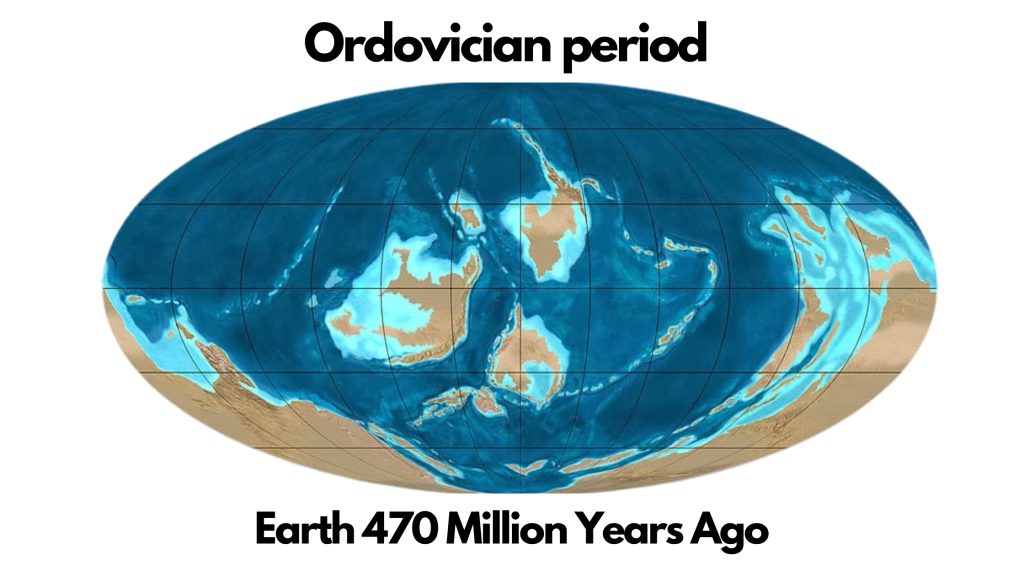
Today, 71% of the Earth’s surface is covered by liquid water: oceans, rivers, underwater worlds, fascinating ice worlds, and unknown caves. No other substance has been studied yet still holds so many questions as water. We went further: what about water beyond the Earth? Is there water in the Solar System and beyond? How does water shape the landscapes of distant worlds, and what can it reveal about the universe’s history? As World Water Day approaches us (22 March), let’s delve into the mysteries of water, both on our own planet and beyond!
Earth: The Blue Planet
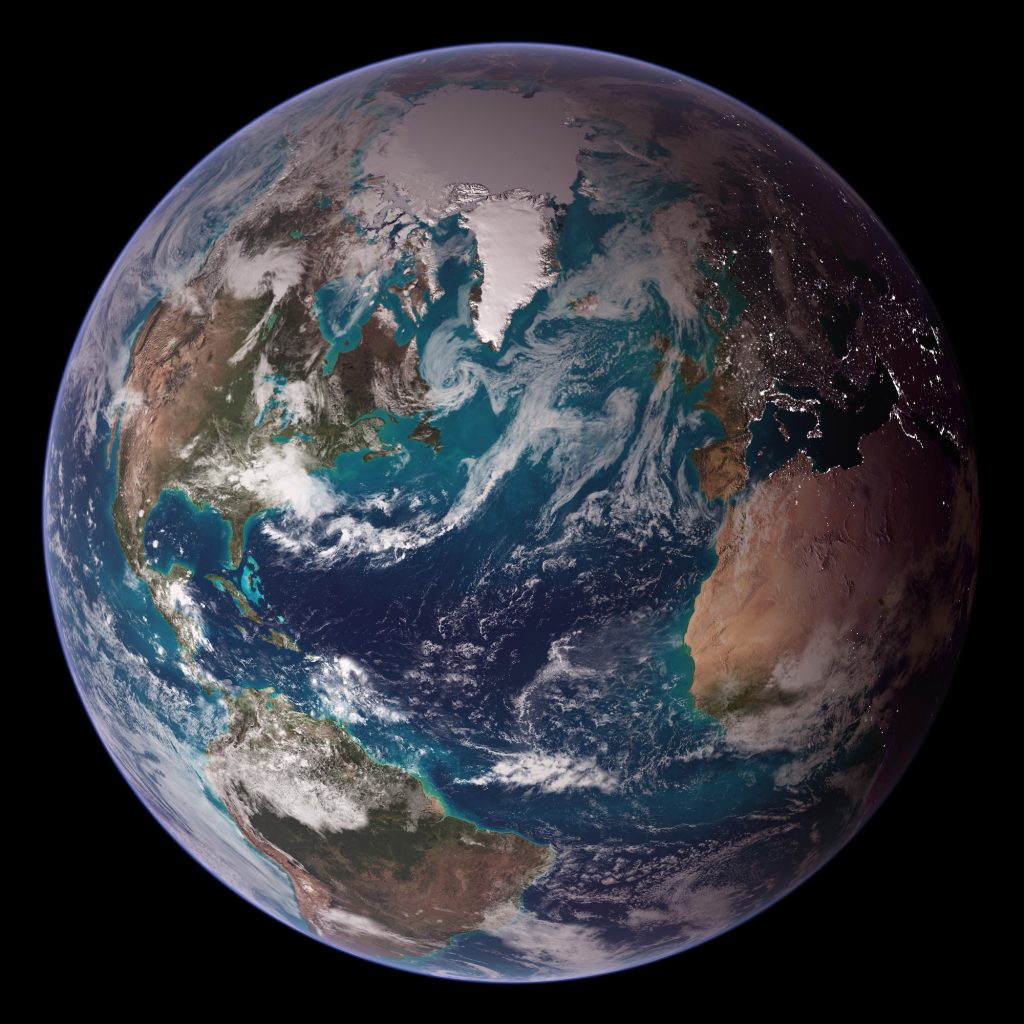
We know that hydrogen and helium were created in the Big Bang. The other elements were created in many generations of stars that lived and died before our solar system was formed. Once those elements were in the solar system, they undertook a complex journey to our planet. Although we are most familiar with the water at the surface, Earth’s water is distributed between different reservoirs:
- The hydrosphere, which includes the atmosphere;
- The crust, which is the rock we’re living on;
- Mantle & core, which are deep beneath our feet.
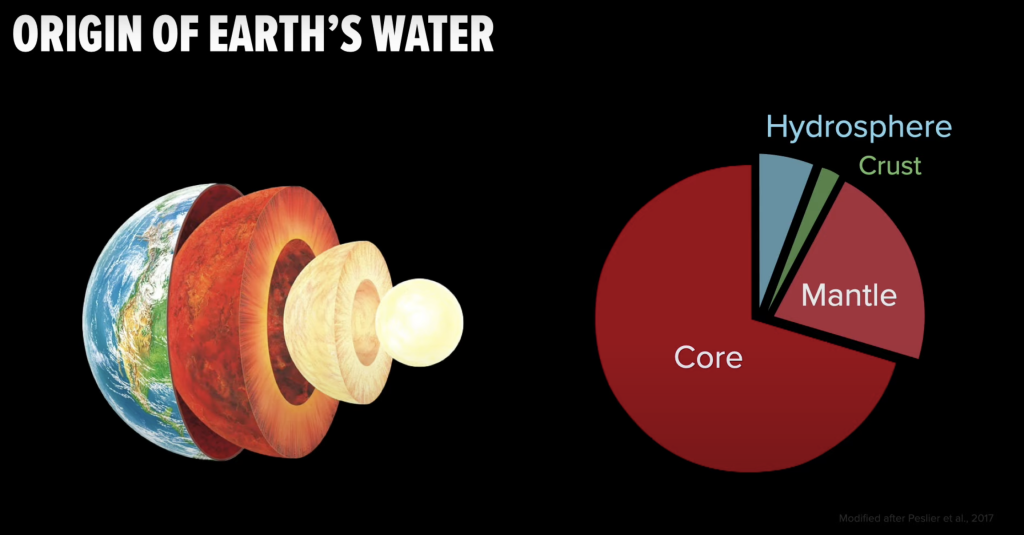
The water inside our planet is locked up in minerals, not as free fluid or ice. Scientists think the Earth’s interior contains between one and seven oceans worth of water. Earth is often referred to as the “Blue Planet” due to its vast oceans and abundant surface water. Approximately 71% of Earth’s surface is covered by oceans, containing approximately 97% of the planet’s water. The remaining 3% is freshwater found in glaciers, rivers, lakes, and underground aquifers.
Water in the Solar System: Where else we can find water?
But our home planet is a desert compared to some places in the solar system, both in terms of its total water volume and the amount of liquid on Earth relative to its size. Think about Jupiter’s moon Europa, covered in ice, which is smaller than Earth’s moon. Scientists recently revisited data from the Voyager spacecraft, collected over 20 years ago, and found even more evidence suggesting Europa might hold twice as much water as Earth. Surprisingly, even the distant dwarf planet Pluto might boast an ocean nearly as large as ours.
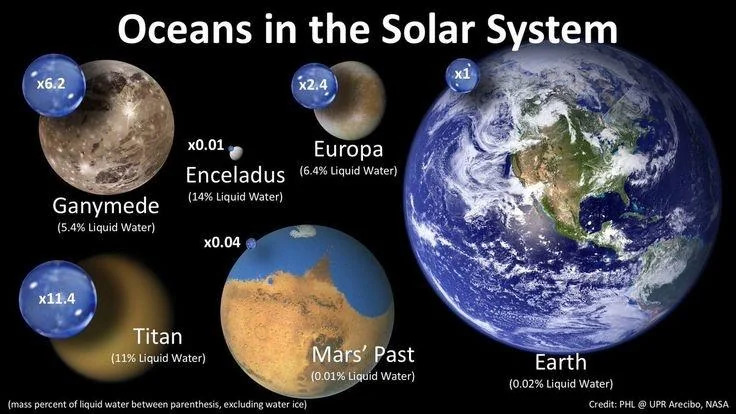
According to the National Oceanic and Atmospheric Administration, Earth falls in the fifth position in the lineup, following Enceladus, Triton, Dione, and Pluto, preceding Europa, Callisto, Titan, and Ganymede. Apparently, there is a lot of water out there, so let’s take a closer look at the water worlds of other planets in our Solar system.
MARS: The Red Planet with Frozen Reservoirs
In space, water can only exist in two forms: as a gas (water vapour) or as a solid (ice). The pressure in space is too low for water to be in its liquid state. When we look at Mars compared to Earth, it truly resembles a vast desert planet. If you were to stand on the surface of Mars, except for near the polar caps, you’d find the ground to be much drier than even the driest desert on Earth.
Yes, Mars is the most Earth-like planet in our solar system, but its water exists primarily in frozen form. While liquid water once flowed on its surface billions of years ago, the present-day Martian environment is too cold and its atmosphere too thin to support liquid water over extended periods.
However, Mars hosts significant quantities of water ice in its polar ice caps and subsurface ice deposits. The polar ice caps consist of a mixture of water ice and frozen carbon dioxide (dry ice), with the northern polar cap being larger and primarily composed of water ice. Additionally, recent discoveries suggest vast reservoirs of underground ice across Martian latitudes, offering potential resources for future human exploration and colonization efforts.
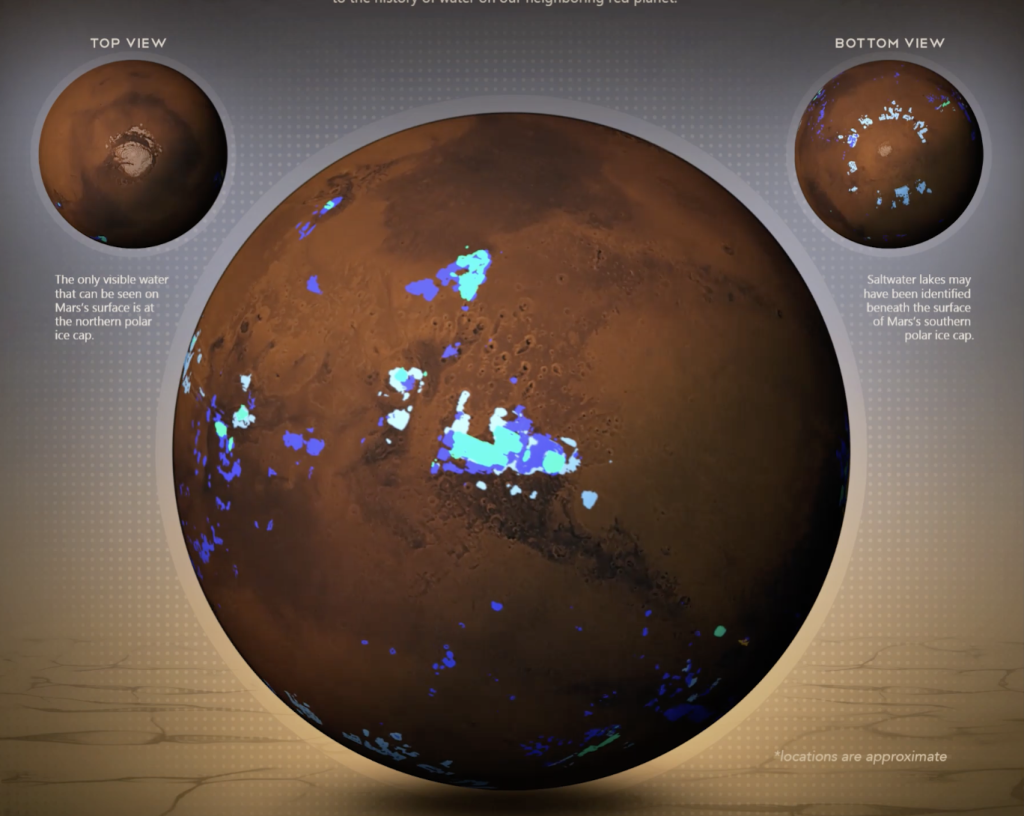
Since the 1960s, both NASA and the European Space Agency (ESA) have deployed specialised instruments to hunt for water on the red planet. Their latest findings unveil a groundbreaking “water map” for Mars. This data reveals that Mars currently holds a significant amount of water, mostly frozen.
Around 4.1 to 3.8 billion years ago, Mars boasted a colossal ocean known as Oceanus Borealis, stretching across its northern hemisphere. Favourable planetary conditions allowed water to flourish on its surface during this epoch. However, shifts in temperature, climate, and geological processes gradually led to the redistribution of water, either evaporating it into the atmosphere or sequestering it underground.
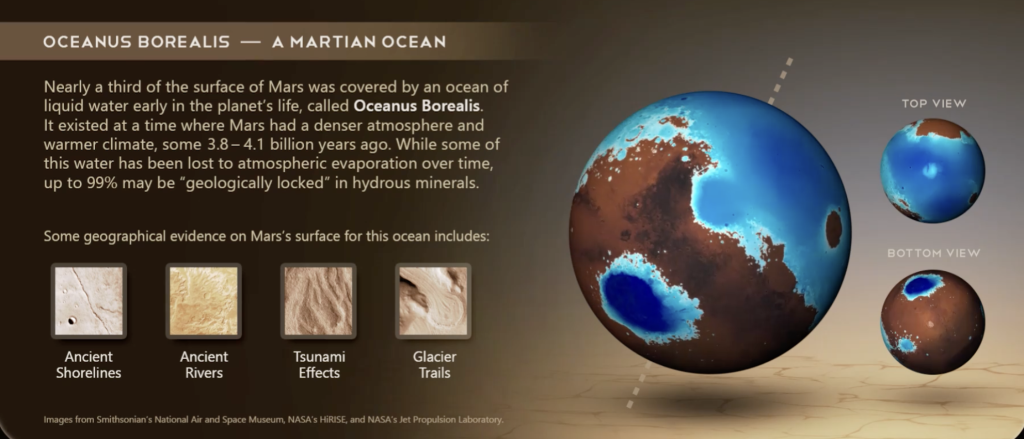
Orbital images of features like outflow channels and valley networks strongly indicate that Mars was much wetter in the past, resembling Earth in having four known water sources or “reservoirs.”
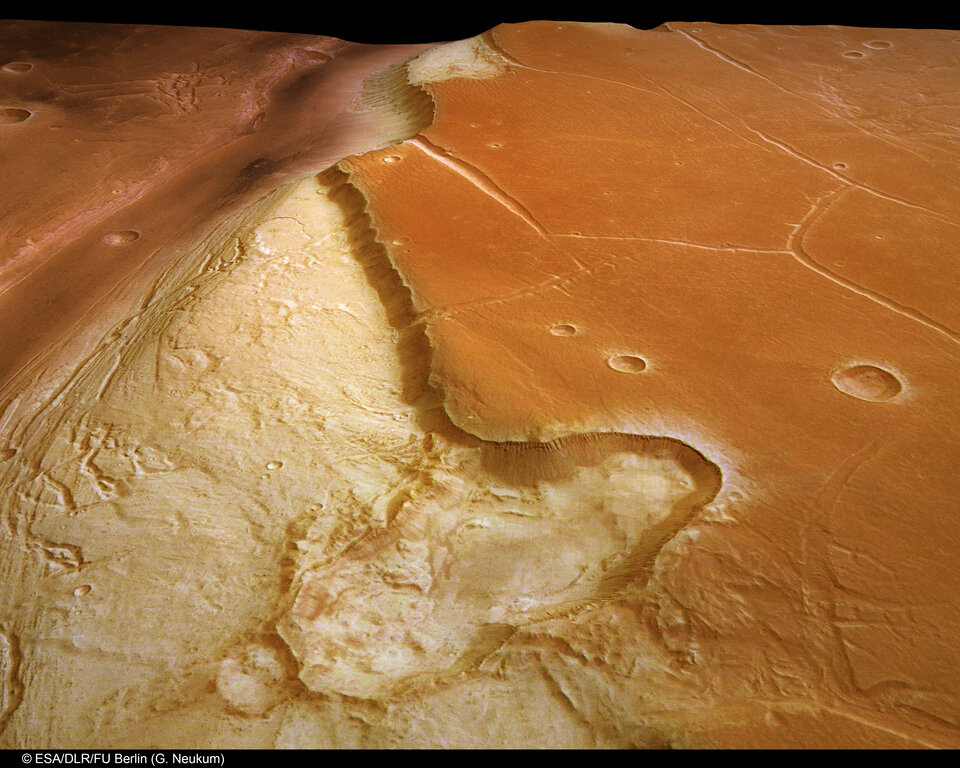
These sources include the atmosphere, containing a minimal amount of water vapour, and ice-rich layers in the polar caps and regions. The third source lies underground in the subsurface. While scientists can measure the water amounts in the first two sources, estimating the subsurface water requires examining how much water was needed to shape visible geologic features.
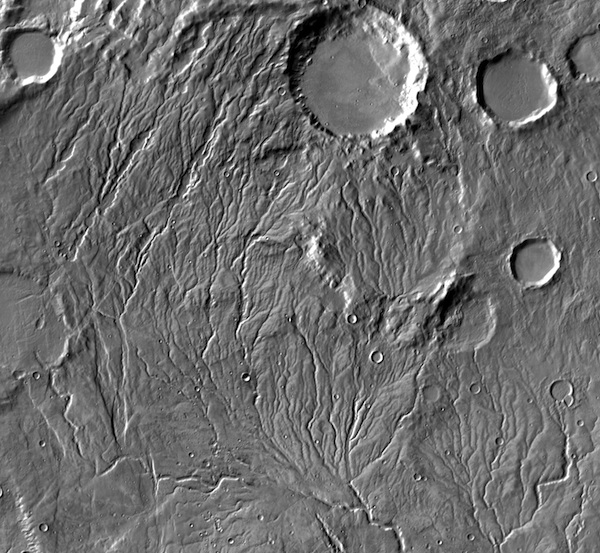
The greatest uncertainty lies in the fourth reservoir: water chemically locked in rocks and minerals like clays. Some studies suggest this reservoir could hold as much water as the other three combined. However, the full extent of these “hydrated” minerals remains unknown, presenting an area for future research and exploration.
Remarkably, up to 99% of this ancient ocean’s water remains trapped within the planet’s crust, ensconced within specialized rocks known as hydrous minerals.
JUPITER: The Ice-Covered Moon Europa

Europa, one of Jupiter’s largest moons, stands out as a promising candidate for extraterrestrial life due to its subsurface ocean beneath an icy crust. While Europa’s surface is primarily composed of water ice, scientists believe a vast liquid water ocean exists beneath its frozen shell.
Tidal heating generated by gravitational interactions with Jupiter and its neighboring moons keeps Europa’s subsurface ocean in a liquid state, potentially providing a habitat for life. Recent observations by spacecraft missions, such as NASA’s Galileo and the Hubble Space Telescope, have detected evidence of geysers erupting from Europa’s surface, suggesting active processes within its subsurface ocean.
The potential presence of liquid water, combined with organic compounds and energy sources, makes Europa a compelling target for future exploration missions aimed at searching for signs of life beyond Earth. Scheduled to launch in October 2024, Europa Clipper’s main science goal is to determine whether there are places below the icy moon’s surface that could be habitable.
Ganymede
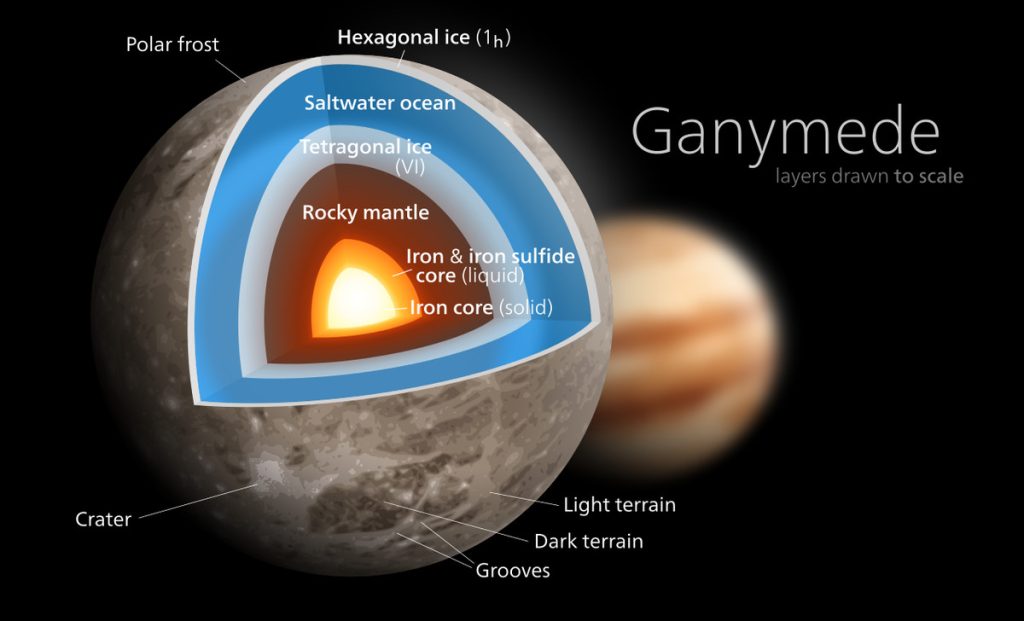
It’s the largest moon of Jupiter and is the wettest world in the solar system for another big reason. Nearly half of its total volume may be liquid water, which is more than any other on the list. Include all the ice the moon has, too, and that share jumps to nearly 70%.
Much of the gas and icy material coming from the inner solar system was intercepted by Jupiter which may be why Jupiter is the largest planet in the solar system. Much of what Jupiter missed was caught by Saturn, making it the second-largest planet. Since most of that material was hydrogen and helium, Jupiter and Saturn became gas giants, although they had substantial amounts of the “ice.”
SATURN: Geyser-Spouting Moon Enceladus
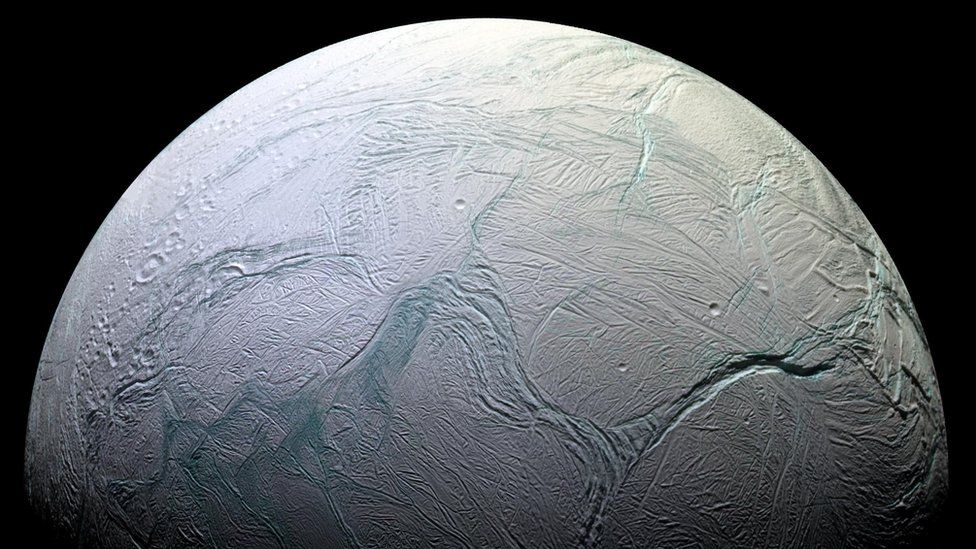
Enceladus, one of Saturn’s icy moons, holds a fascinating secret: geysers shooting out from its south pole. Discovered by NASA’s Cassini spacecraft, these geysers release water vapor, icy particles, and organic molecules into space, hinting at an underground ocean beneath Enceladus’ icy shell.
Much like Europa, Enceladus’ subsurface ocean remains liquid due to tidal heating from Saturn’s gravitational pull. Cassini’s analysis of the geysers showed salts and organic compounds, providing strong evidence for the presence of a global ocean beneath the moon’s surface.
The finding of active hydrothermal vents on Enceladus, along with its liquid water and organic molecules, makes it an enticing target for future astrobiological studies.
Titan: Saturn’s Moon with Liquid Hydrocarbon Lakes
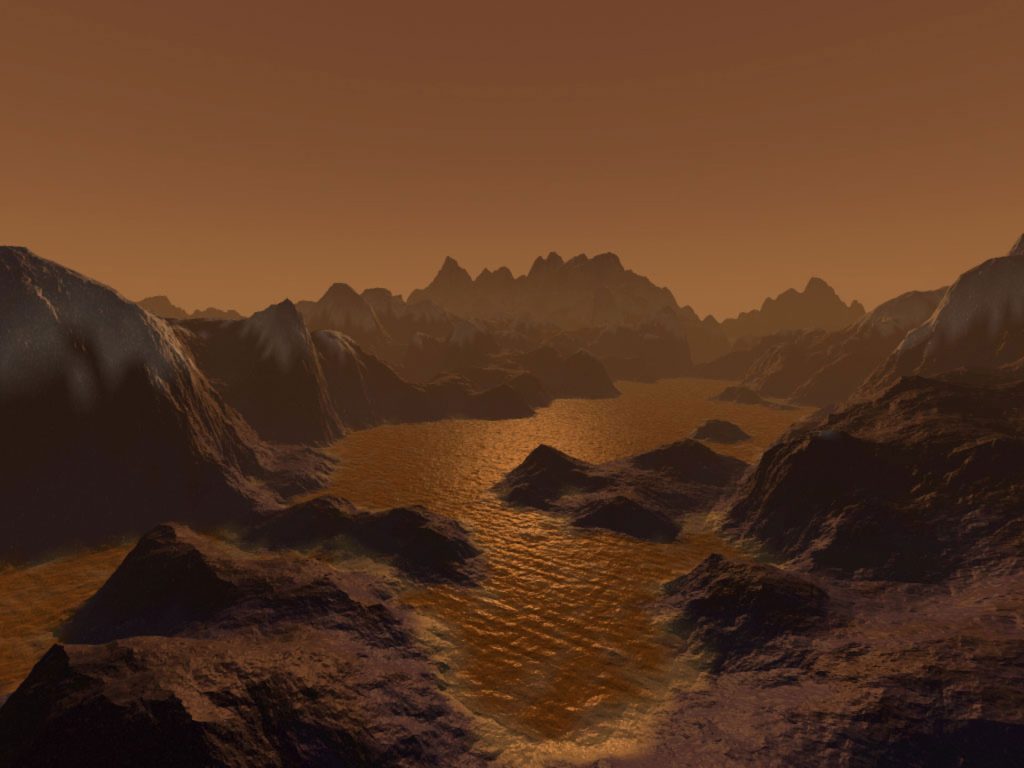
Titan, Saturn’s largest moon, stands apart from other celestial bodies in our solar system due to its dense atmosphere and hydrocarbon-rich surface. While Titan’s surface temperature is too cold for liquid water to exist, it hosts lakes and seas of liquid hydrocarbons, primarily methane and ethane.
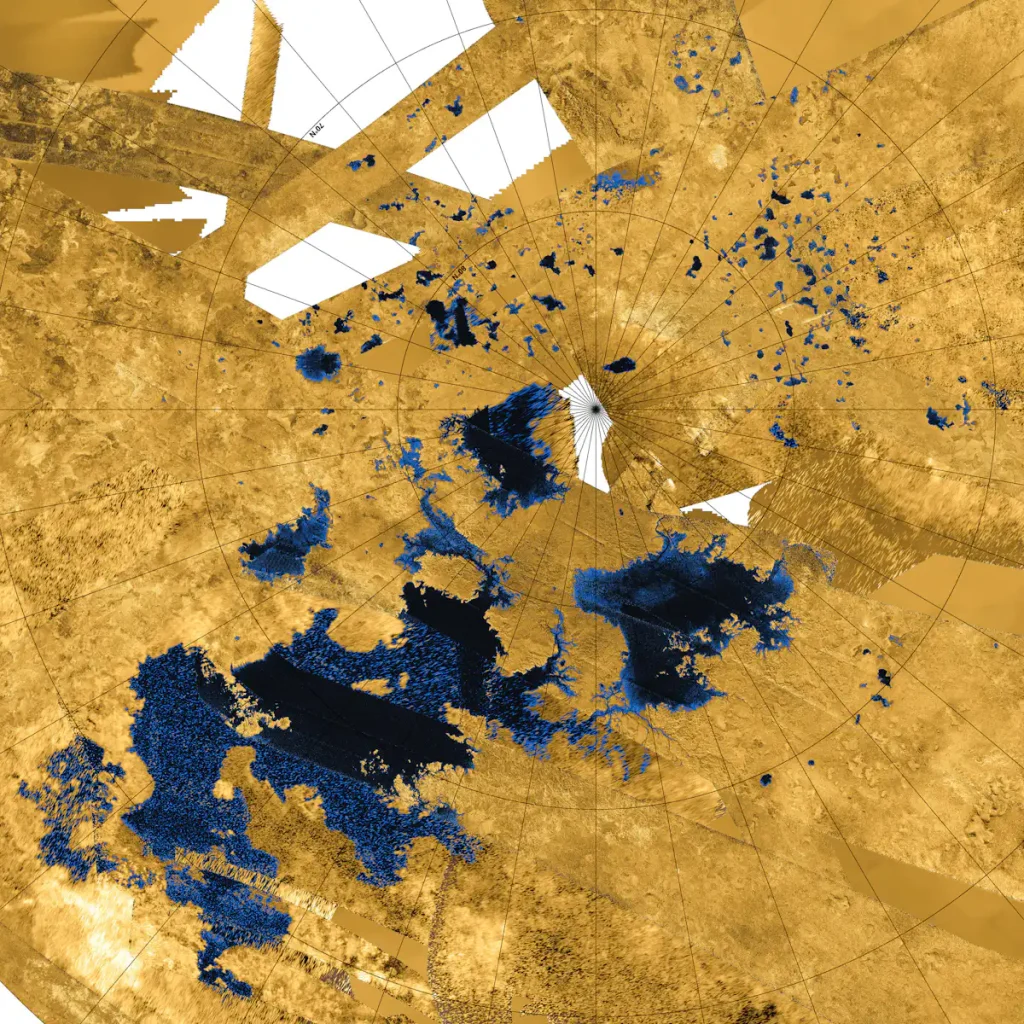
The lakes and seas on Titan’s surface, concentrated near its poles, are believed to form through processes analogous to Earth’s water cycle, with methane raining down from the atmosphere and carving out channels and basins over geological timescales.
Although Titan’s environment differs significantly from Earth’s, its complex organic chemistry and diverse geology make it a fascinating laboratory for studying prebiotic chemistry and understanding the potential for exotic forms of life beyond our planet.
MERCURY: The Sun-Scorched Planet with Ice in Shadowed Craters
Mercury, the closest planet to the Sun, experiences extreme temperature variations between its sunlit and shadowed regions. Despite its proximity to the Sun, recent discoveries have revealed the presence of water ice in permanently shadowed regions near Mercury’s poles.
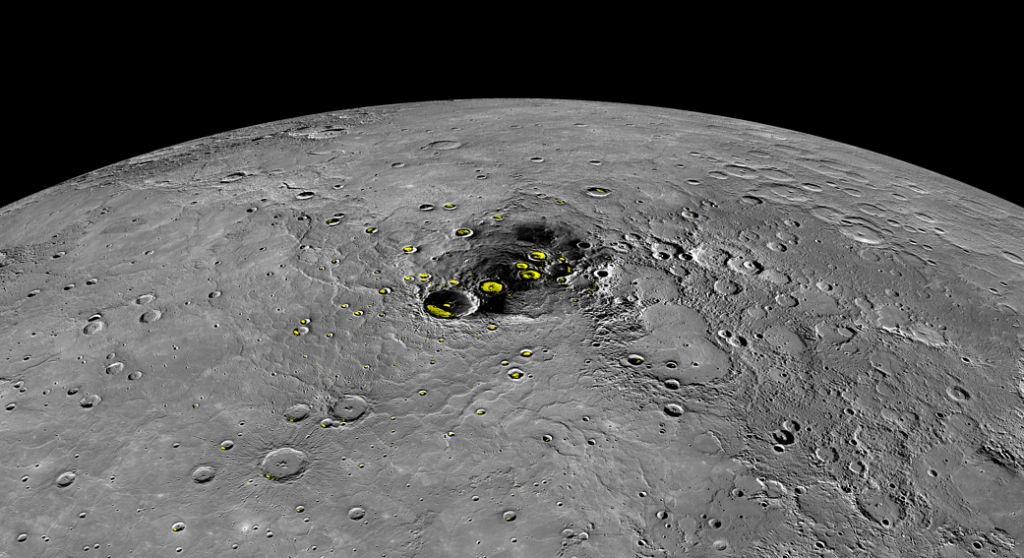
Data from NASA’s MESSENGER spacecraft, which orbited Mercury between 2011 and 2015, provided evidence of water ice deposits within craters near the planet’s north pole. These deposits likely originate from cometary impacts or the delivery of water-rich material from the outer solar system.
The Dwarf Planets: Pluto & Beyond
Beyond the realm of the traditional planets lie the dwarf planets and trans-Neptunian objects of the outer solar system, including Pluto, Eris, and Haumea. While these icy bodies are primarily composed of rock and ice, they offer unique insights into the distribution and abundance of water in the Solar System.
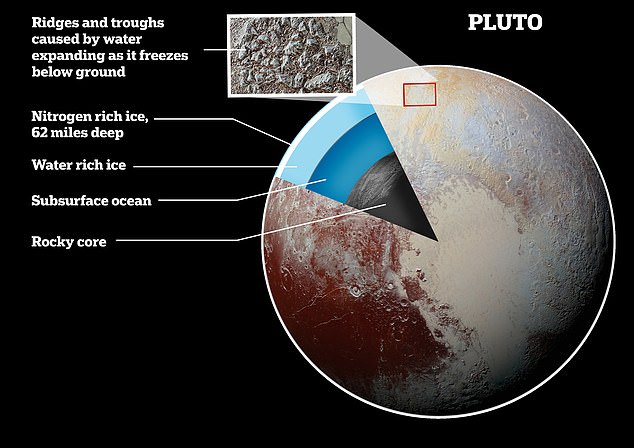
Observations by NASA’s New Horizons spacecraft during its flyby of Pluto in 2015 revealed evidence of water ice on the dwarf planet’s surface, particularly within its prominent heart-shaped feature, informally named Tombaugh Regio. Similarly, studies of other dwarf planets and Kuiper Belt objects have detected signatures of water ice in their spectra, highlighting the prevalence of volatile-rich material in the outer solar system.
Despite their small size and frigid environments, these distant worlds harbor reservoirs of water ice that contribute to our understanding of planetary formation and the evolution of icy bodies in the outer reaches of the solar system.
Let’s Sum It Up – What do we know about water in the Solar System?
In the vast expanse of our solar system, Neptune, Saturn, and Jupiter reign as the giants, concealing immense reservoirs of water within their depths. These colossal planets, ensconced by layers of hydrogen and helium gas, cradle several Earth masses of water, nestled between their rocky cores and outer atmospheres, enduring pressures beyond human comprehension.
While accessing this water remains beyond our current capabilities, the moons orbiting these gas giants offer tantalising prospects. These moons, predominantly composed of ice, harbour not only water but also volatile compounds like methane, ammonia, and carbon monoxide. Despite their frigid environs, certain moons, like Europa and Enceladus, likely conceal internal oceans ripe for exploration in search of life. However, the high salinity resulting from chemical reactions with underlying rock renders these oceans inhospitable to drinkable water.
In contrast, the rocky planets—Mars, Earth, Venus, and Mercury—inhabit a region closer to the sun, where the heat prevents ice from forming during the solar system’s genesis. Instead, these worlds are predominantly rocky, with water either trapped within minerals or delivered via impacting comets.
In our quest to understand the mysteries of water in the Solar System, we are confronted with both the resilience and fragility of this essential molecule. From the icy depths of distant moons to the parched expanses of barren worlds, water serves as a beacon, guiding our exploration and igniting our curiosity about the potential for life beyond Earth’s boundaries.






Thank you for your comment! It will be visible on the site after moderation.